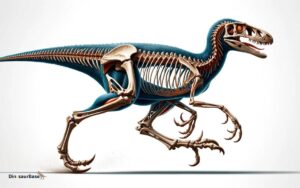What Are Dinosaur Ribs
In a world where smartphones capture moments, the remnants of dinosaur ribs offer a snapshot into a time long before the dawn of technology. These ancient structures, integral to both the anatomy and the mystery of these colossal beings, serve as a bridge to understanding life millions of years ago.
They don't just hint at the size and shape of their owners but also reveal secrets about their breathing mechanisms and behaviors. As one peels back the layers of time, it becomes evident that dinosaur ribs are more than mere bones; they are keys unlocking evolutionary tales that are yet to be fully interpreted.
Why does this matter, and what can these prehistoric puzzles tell us about the world we live in today?
Key Takeaways
- Dinosaur ribs supported breathing, protected vital organs, and provided muscle attachment points.
- Their variety in size and shape indicates diverse adaptations and functionalities.
- Analysis of ribs reveals insights into dinosaurs' diets, social behaviors, and evolutionary pressures.
- Fossilized ribs help date and understand the ecological roles dinosaurs played in their environments.
Defining Dinosaur Ribs
Dinosaur ribs, integral components of the skeletal system, serve as a crucial framework for understanding the anatomy and evolutionary adaptations of these ancient creatures. These bony structures, varying widely among different dinosaur species, offer insights into the diverse lifestyles and habitats.
Scholars meticulously analyze these ribs to deduce their function and contribution to the dinosaurs' survival strategies. For instance, the shape and size of ribs can indicate whether a dinosaur was herbivorous or carnivorous, as well as provide clues about its respiratory efficiency.
Furthermore, studying the arrangement and articulation of ribs allows scientists to reconstruct the body shape and posture of these prehistoric beings, shedding light on their movement and behavior. Thus, dinosaur ribs aren't merely skeletal remains but key to unlocking the mysteries of prehistoric life.
The Anatomy of Ribs
Exploring the anatomy of ribs reveals a complex structure essential for various physiological functions, including protection of internal organs and support for respiratory mechanics.
- Composition: Ribs consist of bone and cartilage, providing both rigidity and flexibility.
- Connection: They connect to the spine at the back and, in most species, to the sternum at the front, forming a protective cage.
- Variation: The number, size, and shape of ribs can vary significantly among different dinosaur species, reflecting adaptations to their environments and lifestyles.
- Function: Beyond protection and support, ribs also play a role in the breathing process, assisting in the expansion and contraction of the thoracic cavity.
This intricate design underscores the ribs' critical role in the survival and functionality of dinosaurs, highlighting their evolutionary success.
Evolutionary Insights
The study of dinosaur rib anatomy offers critical evolutionary insights. It reveals how these ancient creatures adapted to their environments over millions of years. Analysis of the fossil record provides a window into the structural changes and functional adaptations in rib structures. This highlights the dynamic evolutionary processes at play.
This evidence underscores the complexity of dinosaur physiology and its role in their survival and eventual extinction.
Dinosaur Rib Anatomy
Understanding the intricate anatomy of dinosaur ribs sheds light on their evolutionary adaptations and biomechanical functions, revealing insights into the lifestyles and habitats of these ancient creatures. Dinosaur ribs, far from being uniform, varied greatly across different species, each adaptation offering a window into the ecological niches these giants occupied.
- Structural Diversity: Ranging from robust, heavily-built structures in sauropods to more slender, flexible ribs in theropods.
- Support and Protection: Ribs provided essential support for massive bodies and organs, acting as a protective cage.
- Breathing Mechanisms: Variations in rib structure suggest diverse respiratory strategies, critical for metabolic processes.
- Evolutionary Adaptations: The shape and arrangement of ribs indicate evolutionary responses to environmental pressures, such as predation and competition for resources.
This anatomical analysis not only enhances our understanding of dinosaur biology but also enriches our knowledge of prehistoric life on Earth.
Fossil Record Insights
Delving into the fossil record reveals profound evolutionary insights, illustrating how dinosaurs adapted over millions of years to thrive in diverse ecosystems. The skeletal structures, particularly ribs, offer clues to their respiratory systems, dietary habits, and even social behaviors.
| Era | Adaptations | Significance |
|---|---|---|
| Triassic | Simplistic Structures | Early evolutionary stage |
| Jurassic | Rib Expansion | Enhanced breathing |
| Cretaceous | Specialized Ribs | Dietary diversification |
| Modern Findings | Comparative Analysis | Evolutionary connections |
This table encapsulates the evolutionary trajectory of dinosaur ribs, highlighting key adaptations that facilitated their dominance. Each era brought forth distinct changes, from simplistic structures to complex systems, reflecting the dynamic nature of evolution. These insights not only enrich our understanding of prehistoric life but also underscore the intricacies of evolutionary biology.
Ribs and Dinosaur Size
Analyzing the structure of dinosaur ribs provides critical insights into the immense sizes these prehistoric creatures attained. The intricate study of these bony structures helps paleontologists understand not just the physical dimensions but also the growth patterns and health of dinosaurs. Here are key observations:
- Ribs indicate the skeletal framework's capacity to support massive organs and muscles.
- Variations in rib shape and size hint at different adaptations for size across species.
- The spacing and angle of ribs reveal clues about the dinosaur's respiratory volume.
- Analysis of rib growth rings can show the age at which dinosaurs reached their full size.
These findings underscore the importance of ribs in unraveling the mysteries of dinosaur gigantism, offering a window into the evolutionary strategies that allowed these creatures to dominate their environments.
Breathing Mechanisms Uncovered
Through the examination of dinosaur ribs, scientists have unveiled the complex breathing mechanisms these ancient giants used to sustain their massive bodies. This discovery sheds light on how dinosaurs adapted to their environments and managed the oxygen demands of their colossal sizes.
The structure of the ribcage suggests a highly efficient respiratory system, possibly akin to the avian air sac system, which permits a continuous flow of air through the lungs, ensuring maximum oxygen extraction. This revelation not only deepens our understanding of dinosaur physiology but also highlights the evolutionary innovations that supported the survival of these creatures in diverse ecological niches.
Such insights contribute significantly to paleontology, offering a clearer picture of dinosaurian life and their mastery over the ancient landscapes they once roamed.
Dietary Clues From Ribs
The analysis of rib structure in dinosaurs provides profound insights into their dietary habits. It reveals adaptations that align with nutritional needs. Researchers have gleaned nutritional insights by examining the morphology of these ribs. They identify specific traits that correlate with herbivorous or carnivorous diets.
This approach not only enriches our understanding of dinosaur ecology but also underscores the intricacies of their evolutionary adaptations to diverse ecological niches.
Rib Structure Analysis
Examining dinosaur ribs offers invaluable insights into their dietary habits, as variations in rib structure directly correlate with different feeding strategies. Through meticulous analysis, researchers can decipher how these prehistoric creatures adapted their feeding methods to thrive in their respective environments.
- Shape and Size: Larger, more robust ribs suggest a diet requiring significant muscular strength to process, such as tough vegetation or large prey.
- Spacing: Closely spaced ribs indicate a potentially voluminous stomach, suited for digesting large amounts of plant matter.
- Texture and Wear: Signs of wear or unique textures can imply specific repetitive behaviors related to feeding.
- Healing Patterns: Evidence of healed fractures or abnormalities can offer clues about past stresses related to dietary habits, including aggressive hunting or feeding practices.
This analytical approach empowers paleontologists to piece together the dietary puzzles of ancient life, granting freedom from mere speculation.
Nutritional Insights Gleaned
Analyzing dinosaur ribs sheds light on their nutritional habits, revealing how these ancient animals adapted their diets to their environments and physiological needs. Researchers meticulously examine rib composition and morphology to infer dietary preferences and strategies.
They've found variations in rib structures that correlate with different feeding behaviors, such as the robust ribs of herbivores, which support a diet of tough vegetation, and the lighter, more flexible ribs of carnivores, optimized for agility in hunting.
This investigation into rib anatomy not only unravels the dietary inclinations of dinosaurs but also illustrates their ecological roles and evolutionary adaptations. By piecing together these nutritional insights, scientists gain a comprehensive understanding of dinosaur biology, offering a glimpse into the ancient ecosystems where these colossal creatures thrived.
The Role in Movement
Dinosaur ribs played a pivotal role in facilitating their movement, acting as crucial support structures for the muscles and organs involved in locomotion. These bony structures weren't merely passive elements but were actively involved in the dynamism of these ancient creatures. Their role in movement was multifaceted and can be broken down as follows:
- Structural Support: They provided a rigid framework that supported the body's weight.
- Muscle Attachment: Served as anchor points for muscles, enhancing motion efficiency.
- Flexibility: Allowed for a degree of flexibility necessary for breathing, which is critical during physical exertion.
- Protection: Shielded vital organs, indirectly sustaining movement by preventing injuries during dynamic activities.
In essence, dinosaur ribs were indispensable in orchestrating the complex interplay of muscles and bones that enabled these colossal beings to move, breathe, and thrive.
Pathologies and Injuries
Investigations into the fossil record reveal that dinosaur ribs frequently bore the brunt of injuries and pathologies, reflecting their active and often perilous lifestyles. Scholars have meticulously catalogued instances of broken, healed, and malformed ribs, offering insights into the challenges these ancient creatures faced.
These skeletal aberrations aren't merely curiosities; they serve as critical indicators of survival strategies, social behaviors, and environmental pressures. For instance, healed fractures suggest a dinosaur's ability to recover from significant trauma, pointing to robust healing processes or the support of a social group. Pathological conditions, such as infections or tumors, further elucidate the biological stresses that dinosaurs navigated.
Such studies underscore the resilience and adaptability of these prehistoric giants, enriching our understanding of their lives beyond mere bone structures.
Fossilization Process Explained
The fossilization process begins with the formation of fossils, a complex sequence where organic materials are gradually replaced with minerals, preserving the original structure.
Various types of fossilization, including permineralization, casts and molds, and amber encapsulation, provide insights into the diverse conditions under which organisms can be preserved.
Accurately dating fossil records, through methods such as radiometric dating, is crucial for understanding the chronological placement of these ancient specimens within Earth's history.
Formation of Fossils
Fossilization encompasses a complex process where organic materials gradually transform into rock through mineral replacement and sedimentary compaction, preserving ancient life forms in the geological record. This transformation isn't a simple or uniform procedure but involves several crucial stages that contribute to the successful preservation of biological entities from millions of years ago.
- Mineral Replacement: Minerals in groundwater slowly replace the original organic materials, cell by cell.
- Sedimentary Compaction: Overlying sediments compact the remains under immense pressure, aiding in the preservation process.
- Anaerobic Conditions: The lack of oxygen is pivotal in slowing down the decomposition of the organic material.
- Time: The entire process is exceedingly time-consuming, often taking thousands to millions of years to complete.
Understanding these stages offers insight into the intricate nature of fossil formation, revealing the past's locked secrets.
Types of Fossilization
Several methods exist for the preservation of ancient biological remains, each offering a unique window into the process of fossilization. Permineralization, a common method, involves minerals deposited from groundwater, filling the cellular spaces of organisms, thus preserving their structure.
Amber encapsulation captures small organisms in tree resin that hardens over time, providing a clear snapshot of ancient life. Freezing, although rare, offers an almost unchanged preservation of soft tissues, giving invaluable insights into the organism's appearance and genetics.
Mummification, through desiccation in arid environments, prevents decay and preserves soft tissues. Each method reveals different aspects of ancient ecosystems and the organisms within them, enriching our understanding of past life on Earth.
This analytical exploration underscores the diversity and complexity of processes that capture the snapshots of prehistoric life.
Dating Fossil Records
Understanding the age of fossils, a fundamental aspect of paleontology, involves precise scientific techniques that measure the temporal placement of these ancient remains within Earth's history. These methods not only enhance our comprehension of the evolutionary timeline but also allow for a deeper understanding of the environmental conditions that prevailed at different geological periods.
- Radiometric Dating: Utilizes the decay rate of radioactive isotopes to estimate age.
- Stratigraphy: Examines sedimentary rock layers for relative dating.
- Paleomagnetic Dating: Studies Earth's magnetic field reversals captured in rocks.
- Biostratigraphy: Relies on the distribution of fossils within various strata to correlate ages.
Each technique contributes uniquely to constructing a comprehensive chronology of life on Earth, offering insights into the past that fuel our quest for knowledge and freedom from ignorance.
Studying Ribs: Techniques
Researchers employ a variety of advanced imaging techniques to meticulously analyze the structure and composition of dinosaur ribs. These methods provide insights into the lifestyle, health, and evolutionary adaptations of these ancient creatures.
| Technique | Purpose | Advantage |
|---|---|---|
| CT Scanning | Reveals internal structures | Non-destructive; high resolution |
| Microscopy | Examines cellular details | Magnifies fine details |
| Chemical Analysis | Identifies mineral composition | Informs on diet, environment |
| 3D Modeling | Reconstructs shapes and sizes | Visualizes physical attributes |
| Isotope Analysis | Determines geographical origin | Traces migration patterns |
These techniques collectively enable a comprehensive understanding of dinosaur ribs, transcending mere skeletal assessments to explore the very fabric of prehistoric life.
The Diversity of Dinosaur Ribs
The diversity of dinosaur ribs, ranging from their size and shape to their structural complexity, offers profound insights into the evolutionary adaptations and ecological niches these ancient creatures occupied. This variation not only underscores the vast array of dinosaur species but also highlights their specialized roles within prehistoric ecosystems.
- Varying Sizes: From the diminutive ribs of bird-like dinosaurs to the massive, sturdy ribs of sauropods, size variation reflects the broad spectrum of dinosaur body plans.
- Shape and Curvature: The shape and curvature of ribs hint at respiratory adaptations and body support mechanisms.
- Structural Complexity: Some ribs exhibit intricate structures, such as intercostal plates, suggesting advanced muscular and respiratory systems.
- Functional Adaptations: Ribs' adaptation to specific diets and habitats indicates a tight evolutionary relationship between form and function in these majestic creatures.
Implications for Paleontology
Insights into the diversity of dinosaur ribs have profound implications for paleontology, shedding light on evolutionary processes and ecological dynamics of ancient ecosystems. This knowledge not only enriches our understanding of how dinosaurs adapted to their environments but also enhances the accuracy of reconstructing these prehistoric creatures. By examining the variations in rib structures, researchers can infer aspects of dinosaur biology, such as respiration mechanisms and energy needs, that were crucial for their survival and dominance.
| Feature | Implication for Paleontology |
|---|---|
| Rib Shape | Inferences on respiratory mechanics |
| Rib Size | Insights into metabolic rates and growth |
| Rib Placement | Clues to body posture and locomotion methods |
These findings ultimately contribute to a more nuanced view of dinosaur life, offering a window into their world that beckons further exploration and understanding.
Conclusion
In essence, the study of dinosaur ribs unveils a treasure trove of evolutionary secrets, painting a vivid picture of these ancient giants' lives and adaptations. Each rib, a rung on the ladder of prehistoric life, offers unique insights into their breathing mechanisms, size, and even their survival strategies.
Through meticulous analysis and advanced techniques, paleontologists can decipher these bony archives, enriching our understanding of the past. Truly, dinosaur ribs aren't just remnants of a bygone era but keys to unlocking deep evolutionary mysteries.





